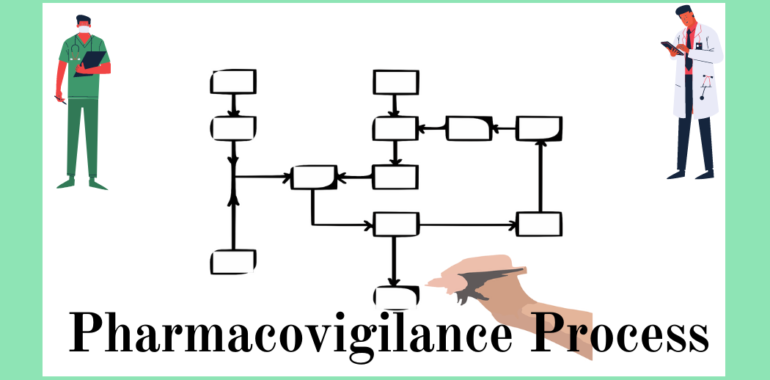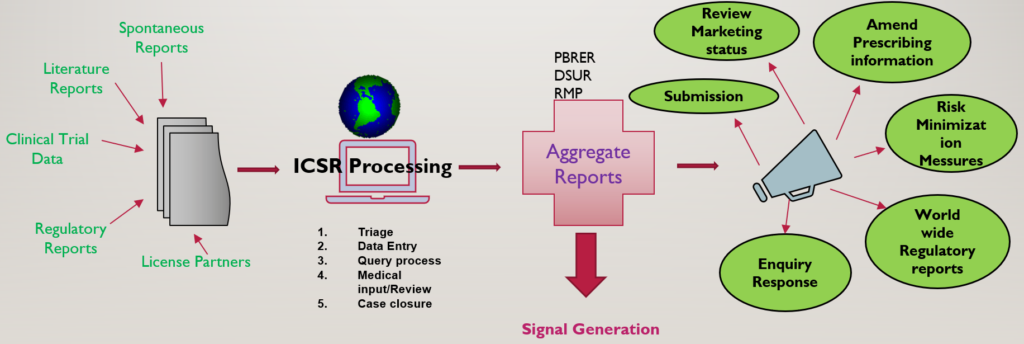What is the Pharmacovigilance process?

What is the Pharmacovigilance process?
What is the Pharmacovigilance process? Simply it is a drug safety monitoring process.
Pharmacovigilance is one of the most important departments in the Pharmaceutical industry.
Before Jumping into the process, let’s look at some facts!
The pharmacovigilance department, (called be Safety Team) collaboratively works with different verticals (like Regulatory, clinical, non-clinical) in the Pharmaceutical industry.
The safety team is responsible for continuously monitoring the safety of its medicinal products for human use.
Apart from safety monitoring of products, they play a key role in writing the regulatory documents for new Marketing authorization holders (MAH) applications.
Pharmacovigilance is not a simple process.
It is a complex system that allows all parties involved in drug development, marketing, and administration to ensure the medicinal product(s) safety.
The exchange of such data is a complex and process involving multiple stages.
Pharmacovigilance is defined by WHO as “detection, assessment, understanding, and prevention of adverse effects or any other drug-related problems”
Table of Contents
Pharmacovigilance process
As defined in the definition, the Pharmacovigilance process consists of 4 stages
- Detection: Collection of Individual Case Safety Reports (ICSRs)
- Assessment
- Understanding and
- Prevention of adverse effects

Pharmacovigilance Process (Stage 1): Detection
Collection of Individual Case Safety Reports (ICSRs)
Pharmacovigilance starts with safety information that comes from different sources such as solicited and unsolicited reporting.
Solicited sources – Received as a result of targeted data collection (i.e., establish a channel to collect the Adverse effects)
- Clinical trials: Phases I-III and post-marketing (non-interventional and interventional studies) and trials
- Registries – organised systems with a predetermined scientific, clinical, or public health purpose
- Personalized programs for non-registered drug administration
Unsolicited sources – Received without request or Spontaneous in nature
- Consumers and Patients (regardless of medical confirmation)
- Healthcare professionals
- Regulatory authorities
- Literature reports
- License Partners
- Lawsuits against medicinal product: Legal cases
- Internet and other media sources
Pharmacovigilance Process (Stage 2): Assessment
After the collection of adverse events, an assessment of ICSRs is conducted
Steps involved in the assessment ICSR
1. Triage
The triage phase of a potential adverse event report involves establishing the validity of an ICSR. A valid ICSR should mandatorily possess the below mentioned four elements
- an identifiable patient
- an identifiable reporter
- a suspect drug
- an adverse event
2. Data Entry
- Every medical product company maintains its own safety database (e.g., Argus, ARISg, etc.)
- After case validation, the Safety associate enters the safety information into the safety database
- The further process in data entry includes
- Seriousness determination
- Coding of adverse events using MedDRA
- Causality assessment
- Labelling assessment
- Clear and concise narrative writing
3. Query process
It involves the raising of queries to the reporter if any additional information is required and also to clarify the discrepancies (if any) in the safety data.
4. Medical input/Review
Safety Physician reviews safety information which is the emphasis on causality, seriousness, labelling, and provides the company pharmacovigilance comments.
Medical review is the first level step in signal detection activities.
5. Case closure
The completed ADR report is Submitted to the respective regulatory authorities.
Pharmacovigilance Process (Stage 3): Understanding the drug safety profile
Aggregate data review is performed to understand the drug safety profile using the following documents
-
- Periodic Benefit-Risk Evaluation Report (PBRER): All spontaneous and clinical trial cases reported during the review period are discussed in detail and benefit-risk analysis is performed
- Specific adverse reaction follow-up questionnaires are used to get the structured information on reported suspected adverse reactions for the important risks.
- Signal Analysis – Every MAH has a proper signal management system and performs the signal analysis.
- Risk Management Plan (RMP)
- Development safety update report (DSUR)
All the above safety documents are periodically submitted to the regulatory authorities.
Pharmacovigilance Process (Stage 4): Prevention of adverse effects
MAH takes action to prevent the Adverse drug reactions by:
- Performing Risk Minimisation Activities i.e., to update the Summary of Product Characteristics, Patient Information Leaflet, Labelling, and packaging of the medicine and Legal status of the medicine.
- Monitoring Risk Minimisation Activities
To know Pharmacovigilance history click on.
3 thoughts on “What is the Pharmacovigilance process?”